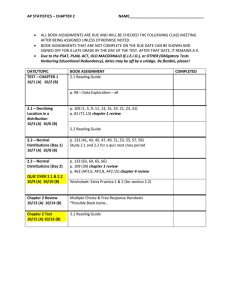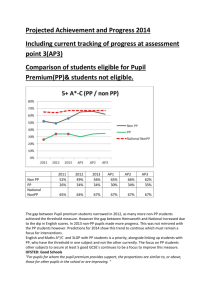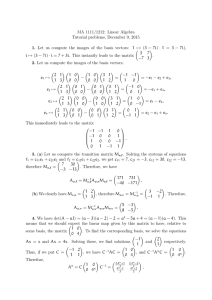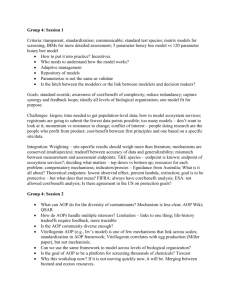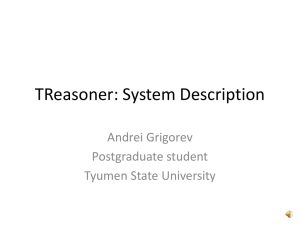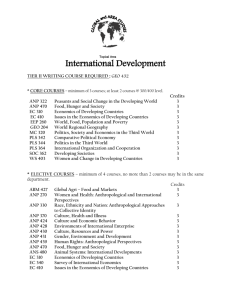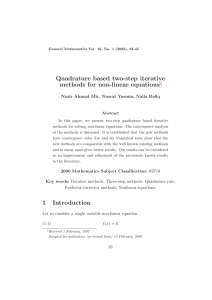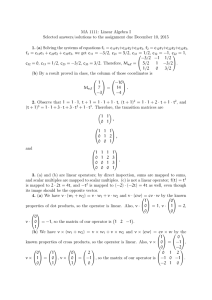Quadrature based three-step iterative method for non-linear equations
advertisement
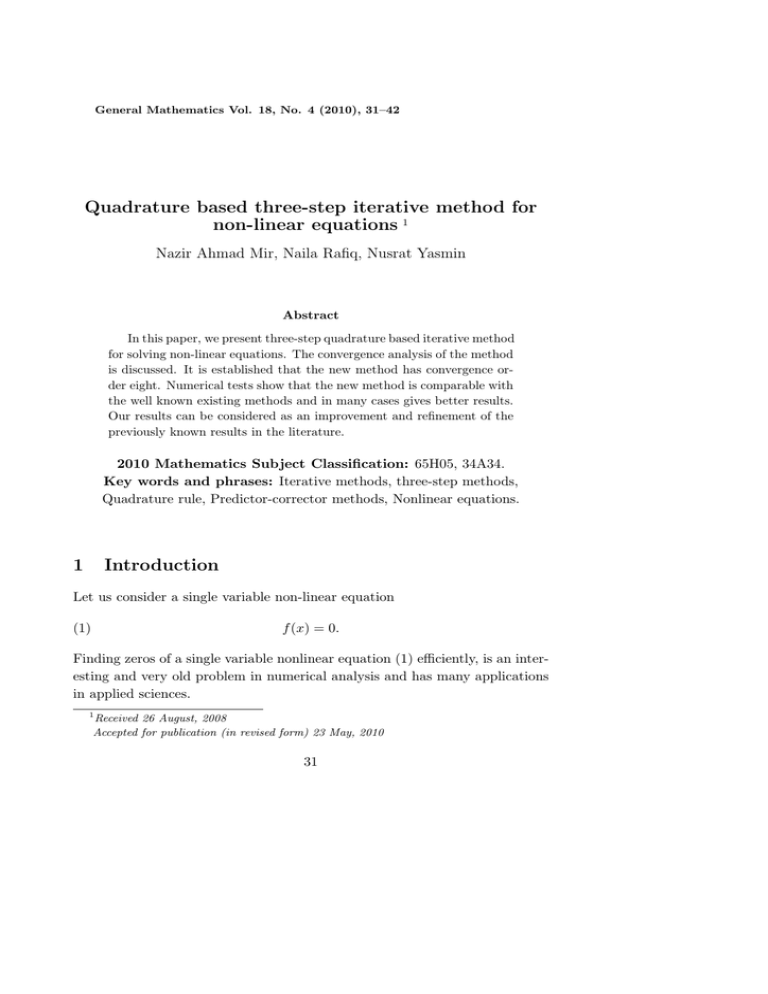
General Mathematics Vol. 18, No. 4 (2010), 31–42 Quadrature based three-step iterative method for non-linear equations 1 Nazir Ahmad Mir, Naila Rafiq, Nusrat Yasmin Abstract In this paper, we present three-step quadrature based iterative method for solving non-linear equations. The convergence analysis of the method is discussed. It is established that the new method has convergence order eight. Numerical tests show that the new method is comparable with the well known existing methods and in many cases gives better results. Our results can be considered as an improvement and refinement of the previously known results in the literature. 2010 Mathematics Subject Classification: 65H05, 34A34. Key words and phrases: Iterative methods, three-step methods, Quadrature rule, Predictor-corrector methods, Nonlinear equations. 1 Introduction Let us consider a single variable non-linear equation (1) f (x) = 0. Finding zeros of a single variable nonlinear equation (1) efficiently, is an interesting and very old problem in numerical analysis and has many applications in applied sciences. 1 Received 26 August, 2008 Accepted for publication (in revised form) 23 May, 2010 31 32 N. A. Mir, N. Rafiq, N. Yasmin In recent years, researchers have developed many iterative methods for solving equation (1). These methods can be classified as one-step, two-step and three-step methods, see[1 − 14]. These methods have been proposed using Taylor series, decomposition techniques, error analysis and quadrature rules, etc. Abbasbandy[2], Chun[4] and Grau[8] have proposed many two-step and three-step methods. In this paper, we present three-step quadrature based iterative method for solving non-linear equations. We prove that the new method has order of convergence eight. The method and its algorithm is described in section 2. The convergence analysis of the method is discussed in section 3. Finally, in section 4, the method is tested on numerical examples given in the literature. It was noted that the new method is comparable with the well known existing methods and in many cases gives better results. Our results can be considered as an improvement and refinement of the previously known results in the literature. 2 The Iterative Method Weerakoon and Fernando [13] ,Gyurhan Nedzhibov [12] and M. Frontini and E. Sormani [6 − 7] have proposed various methods by the approximation of the indefinite integral Zx (2) 0 f (t)dt, f (x) = f (xn ) + xn using Newton Cotes formulae of order zero and one. We approximate, here x + zn with however the integral (2) by rectangular rule at a generic point 2 the end-points x and zn . We thus have: µ Zx 0 f (t)dt = (x − zn )f 0 zn x + zn 2 ¶ this gives (3) 0 −f (zn ) = (x − zn )f ( x + zn ). 2 , Quadrature based three-step iterative... 33 From (3), we have: (4) x − zn = − f (zn ) n f 0 ( x+z 2 ) Therefore, we have: (5) xn+1 = zn − For a generic point wn = the Newton’s method: f (zn ) ∗ n f ( x +z 2 ) 0 x∗ + zn , consider the Ostrowski’s method and 2 (xn − yn )f (yn ) , f (xn ) − 2f (yn ) f (yn ) = yn − 0 . f (yn ) (6) x∗ = yn − (7) zn This formulation allows to suggest many one-step, two-step and three-step methods. We however define the following three-step iterative method: Algorithm 2.1 For a given initial guess x0 , find the approximate solution by the iterative scheme: f (xn ) , f 0 (xn ) ¸ · 1 (xn − yn )f (yn ) f (yn ) = yn − , + 2 f (xn ) − 2f (yn ) f 0 (yn ) f (zn ) = zn − 0 . f (wn ) (8) yn = xn − (9) wn (10) xn+1 where zn is defined by (7). 0 Algorithm 2.1 can further be modified by using an approximation for f (yn ) with the help of Taylor’s expansion. 0 Let yn be defined by (8). If we use Taylor expansion of f (yn ): 0 0 00 f (yn ) ' f (xn ) + f (xn )(yn − xn ), (where the higher derivatives are neglected) in combination with Taylor approximation of f (yn ): 1 00 f (yn ) ' f (xn ) + f 0 (xn )(yn − xn ) + f (xn )(yn − xn )2 , 2 34 N. A. Mir, N. Rafiq, N. Yasmin 0 we can remove the second derivative and approximate f (yn ) as: · ¸ f (yn ) − f (xn ) f (yn ) ' 2 − f 0 (xn ). yn − xn 0 (11) then Algorithm 2.1 can be written in the form of the following algorithm: Algorithm 2.2 For a given initial guess xo ,find the approximate solution by the iterative scheme: f (xn ) , f 0 (xn ) f (yn ) 1 (xn − yn )f (yn ) , i + h = yn − f (y )−f (xn ) n 2 f (xn ) − 2f (yn ) 2 0 − f (xn ) yn −xn (12) yn = xn − (13) wn (14) xn+1 = zn − f (zn ) , f 0 (wn ) where zn is defined by (7). We will compare this method with the Ostrowski’s method, Grau’s method and seventh order method defined in [1] by Jisheng Kou et al. The algorithms of these methods are given below: Algorithm 2.3 For a given initial guess x0 , find the approximate solution by the iterative scheme: (15) (16) f (xn ) , f 0 (xn ) (xn − yn )f (yn ) = yn − . f (xn ) − 2f (yn ) yn = xn − xn+1 Algorithm 2.4 For a given initial guess x0 , find the approximate solution by the iterative scheme: (17) (18) (19) (20) f (xn ) , f 0 (xn ) x n − yn µ = , f (xn ) − 2f (yn ) zn = yn − µf (yn ), yn = xn − xn+1 = zn − µf (zn ). Quadrature based three-step iterative... 35 Algorithm 2.5 For a given initial guess x0 , find the approximate solution by the iterative scheme: f (xn ) , f 0 (xn ) (xn − yn )f (yn ) = yn − , f (xn ) − 2f (yn ) "µ # ¶2 f (yn ) f (zn ) f (zn ) = zn − 1+ + f (xn ) − 2f (yn ) f (yn ) f 0 (xn ) (21) yn = x n − (22) zn (23) xn+1 3 Convergence Analysis Let us now discuss the convergence analysis of the algorithm 2.2 discussed above. Theorem 1 Let α ∈ I be a simple zero of sufficiently differentiable function f : I ⊆ R → R for an open interval I. If x0 is sufficiently close to α, then the algorithm 2.2 has eighth order convergence. Proof.Let α be a simple zero of f and xn = α + en . By Taylor’s expansion, we have: 0 (24) f (xn ) = f (α)(en + c2 e2n + c3 e3n + c4 e4n + c5 e5n + c6 e6n + ¡ ¢ c7 e7n + c8 e8n ) + O e9n , (25) f (xn ) = f (α)(1 + 2c2 en + 3c3 e2n + 4c4 e3n + 5c5 e4n + 6c6 e5n 0 0 +7c7 e6n + 8c8 e7n ) + O(e9n ). where µ (26) ck = 1 k! ¶ f (k) (α) , k = 2, 3, ...and en = xn − α. f 0 (α) 36 N. A. Mir, N. Rafiq, N. Yasmin Using (24) and (25), we have (27) ¡ ¢ ¡ ¢ f (xn ) = en −c2 e2n +2 c22 −c3 e3n + 7c2 c3 −3c4 −4c32 e4n +(6c23 −4c5 0 f (xn ) +8c42 +10c2 c4 −20c3 c22 )e5n +(−5c6 +13c2 c5 −33c2 c23 −16c52 +52c3 c32 +17c4 c3 −28c4 c22 )e6n +(−32c62 +c7 −8c3 c5 +24c22 c5 −8c2 c6 −56c32 c4 −90c22 c23 +52c2 c4 c3 −4c24 +9c33 +112c42 c3 )e7n +(33c23 c4 −54c33 c2 +16c24 c2 −9c4 c5 +96c23 c32 −84c3 c4 c22 +32c3 c2 c5 −2c7 c2 −32c3 c52 −8c5 c32 −9c3 c6 +16c4 c42 +4c6 c22 )e8n +O(e9n ). Using (27) in (12), we thus have: ¡ ¢ ¡ ¢ (28) yn = α+c2 e2n + −2c22 +2c3 e3n − 7c2 c3 −4c32 −3c4 e4n + (4c5 −10c2 c4 +20c3 c22 −8c42 −6c23 )e5n +(28c4 c22 +33c2 c23 +5c6 −52c3 c32 −17c4 c3 −13c2 c5 +16c52 )e6n +(−c7 −52c2 c4 c3 +4c24 −9c33 +56c32 c4 +8c2 c6 −24c22 c5 +90c22 c23 +32c62 +8c3 c5 −112c42 c3 )e7n +(32c3 c52 +54c33 c2 −33c23 c4 +84c3 c4 c22 +9c3 c6 −32c3 c2 c5 +2c7 c2 −4c6 c22 +8c5 c32 −16c4 c42 −16c24 c2 +9c4 c5 −96c23 c32 )e8n ¡ ¢ +O e9n . By Taylor’s series, we have: f (yn ) = (yn − α) f 0 (α) + 1 (yn − α)2 f 00 (α) + ... . 2! Using (28) in the above relation and on simplifying, we have: ¡ ¢ ¡ ¢ (29)f (yn ) = f 0 (α)(c2 e2n +2 c3−c22 e3n + −7c2 c3 +3c4 +5c32 e4n +(24c3 c22 −12c42 +4c5 −10c2 c4 −6c23 )e5n +(37c2 c23 −73c3 c32 +28c52 +34c4 c22 +5c6 −17c4 c3 −13c2 c5 )e6n +(−40c2 c4 c3 +56c22 c23 −34c42 c3 +24c32 c4 −16c22 c5 −c7 +4c24 −9c33 +8c2 c6 +8c3 c5 )e7n +(−23c3 c4 c22 −16c3 c2 c5 −33c23 c4 +42c33 c2 −7c24 c2 +9c4 c5 +78c23 c32 +2c7 c2 −216c3 c52 −34c5 c32 +9c3 c6 +105c4 c42 +6c6 c22 +80c72 )e8n )+O(e9n ). Quadrature based three-step iterative... 37 Using (24), (25), (28) and (29) in (11), we have: (30) f 0 (yn ) = f 0 (α)(1+(2c22 −c3 )e2n +(−4c32 −2c4 +6c2 c3 )e3n +(−3c5 −16c3 c22 +4c23 +8c2 c4 +8c42 )e4n +(−22c4 c22 +10c2 c5 +40c3 c32 −16c52 +10c4 c3 −18c2 c23 −4c6 )e5n +(−5c7 +6c24 −48c2 c4 c3 +58c32 c4 −28c22 c5 +62c22 c23 +32c62 +12c2 c6 −4c33 −96c42 c3 +12c3 c5 )e6n +(64c72 −6c8 +108c4 c42 −32c33 c2 +14c6 c22 +14c4 c5 +244c23 c32 −46c5 c32 +14c3 c6 −104c3 c4 c22 −256c3 c52 −14c23 c4 )e7n +(870c22 c33 −14c6 c32 −528c2 c23 c4 +2c8 c2 +48c2 c5 c4 +8c25 +768c3 c62 +16c6 c4 −1504c42 c23 −128c82 +1050c3 c32 c4 −288c4 c52 − 126c24 c22 − 50c43 + 2c3 c7 + 44c5 c23 + 88c6 c2 c3 − 348c22 c5 c3 − 2c7 c22 +16c24 c3 +86c42 c5 )e8n )+O(e9n ). Using (28), (29) and (30) in (7), we have: ¡ ¢ (31)zn = α + (−c2 c3 + c32 )e4n + −2c23 + 8c3 c22 − 2c2 c4 − 4c42 e5n + (10c52 +18c2 c23 − 7c4 c3 + 12c4 c22 − 30c3 c32 − 3c2 c5 )e6n + (−4c2 c6 +80c42 c3 − 40c32 c4 + 16c22 c5 + 52c2 c4 c3 − 10c3 c5 − 80c22 c23 +12c33 − 20c62 − 6c24 )e7n + (252c23 c32 + 37c24 c2 + 68c3 c2 c5 +50c23 c4 − 17c4 c5 − 178c3 c52 − 209c3 c4 c22 + 101c4 c42 − 51c5 c32 +20c6 c22 − 5c7 c2 − 13c3 c6 − 91c33 c2 + 36c72 )e8n + O(e9n ). By Taylor’s series, we have: f (zn ) = (zn − α) f 0 (α) + 1 (zn − α)2 f 00 (α) + ... . 2! Using (31) in the above relation and on simplifying, we have: (32) f (zn ) = f 0 (α)(c2 (−c3 +c22 )e4n +(8c3 c22 −2c2 c4 −4c42 −2c23 )e5n +(−30c3 c32 +18c2 c23 +10c52 −3c2 c5 +12c4 c22 −7c4 c3 )e6n +(−4c2 c6 +80c42 c3 −40c32 c4 +16c22 c5 +52c2 c4 c3 −10c3 c5 −80c22 c23 +12c33 −20c62 −6c24 )e7n +(253c23 c32 +37c24 c2 +68c3 c2 c5 +50c23 c4 −17c4 c5 −180c3 c52 −209c3 c4 c22 +101c4 c42 −51c5 c32 +20c6 c22 −5c7 c2 −13c3 c6 −91c33 c2 +37c72 )e8n )+O(e9n ). 38 N. A. Mir, N. Rafiq, N. Yasmin Using (24), (27), (28) and (29) in (13), we have: (33) wn = α+(−c2 c3 +c32 )e4n −2c23 +8c3 c22 −2c2 c4 −4c42 )e5n +(10c52 +18c2 c23 −7c4 c3 +12c4 c22 −30c3 c32 −3c2 c5 )e6n +(−4c2 c6 +80c42 c3 −40c32 c4 +16c22 c5 +52c2 c4 c3 −10c3 c5 −80c22 c23 +12c33 −20c62 −6c24 )e7n 3 +(4c72 +50c23 c4 −137c3 c4 c22 +44c23 c32 − c7 c2 −13c3 c6 +53c3 c2 c5 2 155 3 − c c2 −21c5 c32 +37c4 c42 −58c3 c52 +8c6 c22 +29c24 c2 −17c4 c5 )e8n 2 3 +O(e9n ). By Taylor’s series, we have: (34) f 0 (wn ) = f 0 (α)(1+(−2c3 c22 +2c42 )e4n +(−4c2 c23 −8c52 +16c3 c32 −4c4 c22 )e5n +(−14c2 c4 c3 +24c32 c4 +20c62 +36c22 c23 −60c42 c3 −6c22 c5 )e6n +(32c5 c32 −160c23 c32 −80c4 c42 +24c33 c2 +104c3 c4 c22 −40c72 − 20c3 c2 c5 −8c6 c22 −12c24 c2 +160c3 c52 )e7n +(282c23 c42 −34c2 c5 c4 +106c22 c5 c3 −3c7 c22 +74c4 c52 −152c22 c33 +100c4 c23 c2 +58c24 c22 −113c62 c3 −274c4 c3 c32 +8c82 +16c6 c32 −42c42 c5 −26c6 c2 c3 )e8n ) +O(e9n ). Using (31), (32) and (34) in (14), we have: (35) xn+1 = α + (c72 + c23 c32 − 2c3 c52 )e8n + O(e9n ), or (36) en+1 = (c72 + c23 c32 − 2c3 c52 )e8n + O(e9n ). Thus, we observe that the algorithm 2.2 has eighth order convergence. 4 Numerical examples We consider here some numerical examples to demonstrate the performance of the new developed three-step iterative method, namely algorithm 2.2. We compare the methods defined in J.Kou et al. ( algorithm 2.3 (G4 ), algorithm 2.4 (G6 ), and algorithm 2.5 (G7 ) and the new developed three-step method Quadrature based three-step iterative... 39 algorithm 2.2 (M N ) in this paper. All the computations are performed using Maple 10.0. We take ∈= 10−15 as tolerance. The following criteria is used for estimating the zero: (i) δ = |xn+1 − xn | < ∈ (ii) |f (x (n ))| <∈ The following examples of J.Kou et al. [1] are used for numerical testing: Example f1 = x3 f2 = 2 xex + Exact Zero 4x2 − 15, α = 1.6319808055660636, 2 − sin (x) + 3 cos(x) + 5, f3 = sin(x) − 12 x, f4 = 2 10xe−x α = −1.207647827130919, α = 1.8954942670339809, − 1, α = 1.67963061042845, f5 = cos(x) − x, α = 0.73908513321516067, f6 = sin2 (x) − x2 + 1, α = 1.4044916482153411, f7 = e−x +cos(x), α = 1.74613953040801241765. For convergence criteria, it was required that δ, the distance between two consecutive iterates was less than 10−15 , n represents the number of iterations and f (xn ), the absolute value of the function. All the values are computed with 350 significant digits. The numerical comparison is given in Table 4.1. f1 , x0 = 2 G4 G6 G7 MN f2 , x0 = −1 G4 G6 G7 MN f3 , x0 = 2 G4 G6 G7 MN n f (xn ) 3 3 3 3 1.03e-228 4.46e-179 1.06e-274 1.00e-348 3 3 3 3 8.82e-223 2.54e-155 1.20e-264 2.79e-259 3 3 3 3 5.12e-313 8.44e-252 3.00e-320 3.00e-350 40 N. A. Mir, N. Rafiq, N. Yasmin f4 , x0 = 1.8 G4 G6 G7 MN f5 , x0 = 1 G4 G6 G7 MN f6 , x0 = 1.6 G4 G6 G7 MN f7 , x0 = 2 G4 G6 G7 MN Table 4.1. 5 n f (xn ) 3 3 3 3 1.16e-236 9.37e-187 1.34e-281 0 3 3 3 3 7.05e-296 4.12e-237 0 0 3 3 3 3 3.26e-226 7.54e-178 6.26e-271 1.00e-349 3 3 3 3 1.05e-279 1.58e-223 3.00e-320 3.00e-350 CONCLUSION From Table 4.1, we observe that our three-step iterative method is comparable with the methods defined in the paper of Jisheng Kou et al. [1] and in many cases gives better results in terms of the function evaluation f (xn ). Moreover 1 the computational efficiency of the algorithm 2.2 i.e. 8 5 ' 1.515717 is better than the efficiency of most of the other methods defined in the literature. References [1] J. Kou, et al., Some variants of Ostrowski’s method with seventh-order convergence, J. Comput. Appl. Math., 2006, doi:10.1016/j.cam.2006.10.073. Quadrature based three-step iterative... 41 [2] S. Abbasbandy, Improving Newton-Raphson method for nonlinear equations by modified Adomian decomposition method, Appl. Math. Comput. 145, 2003, 887-893. [3] R. L. Burden, J. D. Faires, Numerical Analysis, PWS publishing company, Boston USA, 2001. [4] C. Chun, Iterative methods improving Newton’s method by the decomposition method, Comput & Math with Appl. 50, 2005, 1559-1568. [5] J.E.Dennis, R.B. Schnable, Numerical methods of unconstraind optimization and non-linear equations, Prentice Hall, 1983. [6] M. Frontini, E. Sormani, Some variants of Newton’s method with third order convergence and multiple roots, J. Comput. Appl. Math. 156, 2003, 345-354. [7] M. Frontini, E. Sormani, Third order methods for quadrature formulae for solving system of nonlinear equations, Appl. Math. Comput. 149, 2004, 771-782. [8] M. Grau, J.L. Diaz-Barrero, An improvement to Ostrowski root-finding method, Appl. Math. Comput. 173, 2006, 450-456. [9] Jisheng Kou, Yitian Li and Xiuhua Wang, Third order modification of Newton’s method, Appl.Math. and Comput.,(2006, in press). [10] M. V. Kanwar, V. K. Kukreja, S. Singh, On a class of quadratically convergent iteration formulae, Appl. Math. Comput. 166 (3), 2005, 633-637. [11] Mamta, V. Kanwar, V. K. Kukreja, S. Singh, On some third order iterative methods for solving non-linear equations, Appl. Math. Comput. 171, 2005, 272-280. [12] Gyurhan Nedzhibov, On a few iterative methods for solving nonlinear equations, Application of Mathematics in Engineering and Economics, in: Proceedings of the XXVIII Summer School Sozopol 2002, Heron Press, Sofia, 2002. [13] S. Weerakoon, T. G. I. Fernando, A variant of Newton’s method with accelerated third order convergence, Appl. Math. Lett. 13, 2000, 87-93. 42 N. A. Mir, N. Rafiq, N. Yasmin [14] A.M.Ostrowski, Solutions of Equations and System of Equations, Academic Press, New York, 1960, 65-71. Nazir Ahmad Mir Mathematics Department Preston University 44000 Islamabad, Pakistan e-mail: nazirahmad.mir@gmail.com Naila Rafiq, Nusrat Yasmin Centre for Advanced Studies in Pure & Applied Mathematics, Bahauddin Zakariya University, Multan, Pakistan e-mail: nrafiqnaila@yahoo.com, nusyasmin@yahoo.com
